October 3, 2016 – Volume 18 #6
In This Issue
Flanigan’s Eco-Logic
First American Offshore Wind
Biophilic Design
CA Climate Leadership Continues
California’s Cap and Trade
Rick Heede and the Carbon Majors
Cities Going 100% Renewable
What’s Up at EcoMotion?
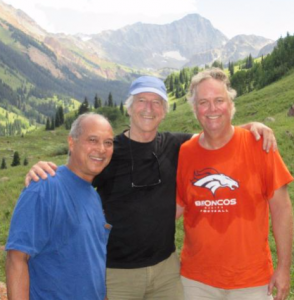
Flanigan‘s Eco-Logic: Hiking Colorado’s Maroon Bells
Michael Totten, Chris Tribble, and I have done trips for decades, there’s a special chemistry that fills our souls. This time it’s hiking in the Maroon Bells near Aspen, Colorado. We travel, rap and relate, laugh, aspire, and inspire. These friendships flourish with adventure, yours too no doubt.
Capital Lake
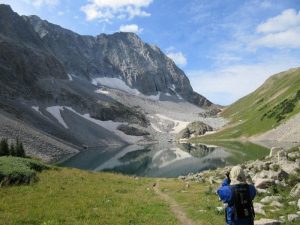 This summer it’s backpacking to Capitol Lake (11,580 feet), an absolutely idyllic high alpine lake in the Bells. We begin at about 9,000 feet, looking south and up the Capitol Creek valley. It is post-card perfect. The lake is at the base of the notorious, 14,137-foot Capital Peak. It rises high above us, known for its infamous “knife-edge”… a narrow strip on the ridge that one has to traverse to summit.
This summer it’s backpacking to Capitol Lake (11,580 feet), an absolutely idyllic high alpine lake in the Bells. We begin at about 9,000 feet, looking south and up the Capitol Creek valley. It is post-card perfect. The lake is at the base of the notorious, 14,137-foot Capital Peak. It rises high above us, known for its infamous “knife-edge”… a narrow strip on the ridge that one has to traverse to summit.
Summits we did not, but we log 31 miles of hiking, all over 9,000 feet, in five days. My sea level training was inadequate. We were in the presence of many of Colorado’s esteemed “fourteeners” of which there are 53 in Colorado. Thanks to Michael and Chris for the main trek, Austin for setting the pace for round two, Bill and Kathy for jumping in for round three and to totally wipe me out, to fulfill my summer alpine trekking.
Gorgeous Rockies they are indeed, marked by sharp rocky peaks, snow fields and crevasses, the bluest of blue skies, aspen trees, rushing streams, pine trees in north-facing valleys. We drive to the trailhead in Old Snowmass, then don our packs for the eight-mile, 2,750-foot ascent to the lake. We pass through forests of shimmering aspens and huff and puff up steep hillsides of berry bushes, crossing the rushing creek several times. The trail rises again and again, we gasp for air and pull hard at our shoulder straps. Within hours we are far from civilization. This is not Los Angeles.
At last we get to Capitol Lake. We look back and admire the valley from on high. What great satisfaction. It’s late afternoon… the lake is nestled below the massive Capital Peak. Precious late sunshine highlights the mountain-tops facing west. We’re whooped, the altitude beating us. We make camp and skip dinner. Late at night it’s so clear to me… that the effort to get out in the wilderness – far from cell coverage and the barrage of media – is so worth it. The feeling is profound. Unplugged.
The next day we revel in the solace and scenic beauty of Capitol Lake. Some campers have left early to summit the Peak. It’s just us in this majestic cirque. How can this place be our own? It’s spectacular beyond words. The water is cold and clear and a rich blue-green in color. There’s nobody here. No cell coverage. Nothing but man in nature in the presence of massive peaks and valleys. Huge clouds punctuate the sky.
Chris fishes; I read. The rainbow trout are jumping and he catches dinner. We head back to camp, light rain becomes heavy rain, then hail, slush, and snow… mountain weather. There’s a saying in Colorado that if you don’t like the weather, wait five minutes. We take cover in our tents, and in a couple hours the storm passes, then the sun shines bright. We spend the rest of daylight drying out.
Lost Man Loop
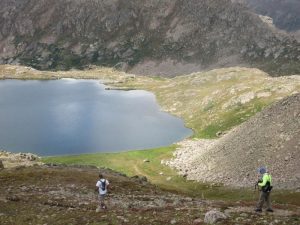 Chris’s son Auston joins us for the next hike to Lost Man Loop. It’s is one of Aspen’s most special day hikes. It begins high up Independence Pass at about 10,000 feet. There we leave car and climb for 2.5 miles to hit the ridge of Lost Man Pass at 12,800 feet. The highest alpine meadows, passing shimmering lakes, and mountainsides dusted with snow. Over the pass, we switchback down to Lost Man Lake. There we sit on rocks at its shores, again all alone in nature’s great majesty, the sun radiating and reflecting off the rippled waters. A breeze cools us; clouds billow above.
Chris’s son Auston joins us for the next hike to Lost Man Loop. It’s is one of Aspen’s most special day hikes. It begins high up Independence Pass at about 10,000 feet. There we leave car and climb for 2.5 miles to hit the ridge of Lost Man Pass at 12,800 feet. The highest alpine meadows, passing shimmering lakes, and mountainsides dusted with snow. Over the pass, we switchback down to Lost Man Lake. There we sit on rocks at its shores, again all alone in nature’s great majesty, the sun radiating and reflecting off the rippled waters. A breeze cools us; clouds billow above.
Visiting RMI and Amory Lovins
 We’re resting our bones in the Roaring Fork Valley! Six stiff legs, all sorts of sore muscles. Someone said something about his feet. A day off from hiking, and we’re in the Versatile studio recording a podcast. Chris does a two-camera shoot. Lights, cameras, action. I interview; Michael Totten explains his current work with Jeremy Rifkin in Luxemburg. The interview gets personal: “Just what it is that keeps you motivated and so focused on our future?” Afterwards, its time for Glenwood’s classic vapor caves.
We’re resting our bones in the Roaring Fork Valley! Six stiff legs, all sorts of sore muscles. Someone said something about his feet. A day off from hiking, and we’re in the Versatile studio recording a podcast. Chris does a two-camera shoot. Lights, cameras, action. I interview; Michael Totten explains his current work with Jeremy Rifkin in Luxemburg. The interview gets personal: “Just what it is that keeps you motivated and so focused on our future?” Afterwards, its time for Glenwood’s classic vapor caves.
We stop by the new Rocky Mountain Institute (RMI) headquarters in Basalt to visit Amory Lovins, its founder and chief, one of my most influential mentors. As we pull up to the new headquarters, I flash back to 1987 and the beginnings. RMI has come a long way. Amory’s at his standing desk, deep in sources and thoughts collected on three monitors. We reminisce, catch up, take photos. He’s proud. We talk flexible LEDs, chairs that cool, the building’s solar and tilt angles, storage and batteries’ demand limiting/rate tariff optimization. The new building is bright and fresh, a great meeting space with break-out rooms. Staff congregates with pleasant chatter in the kitchen. Bikes out front, and as if planted, a young lady softly strums her guitar on the patio.
It was RMI where my mind was blown in the most positive way. Each of us has the power to make a huge difference. Amory catalyzed my understanding of potentials. He showed me the great value of convincing arguments with detailed analyses to back them up. So many great memories… from the first lighting “monologue” that detailed the potential for 91% savings of all U.S. lighting energy at a negative net marginal cost, to the original headquarters and its pair of un-caged iguanas, to visiting with Gorbachev in the Kremlin thanks to Hal Harvey. So many lasting friendships: Sardo, Michael Shepard, Rick Heede, Pat Kiernan, Laura Maggos, Bartlett, Dave Houghton, June Weintraub… all still in my life.
One of our favorite interns at RMI during my tenure was Dave Bill, an Alaskan fisherman of some note who was drawn to RMI. He said listening to Amory Lovins speak is like drinking from a fire hose. And he wanted that, and got it, as did we all. Amory’s wit is endless; he’s got a lot to say about the soft energy path. And we were, and all continue to be on his path of hard work, impacting the planet. Amory liked to say that we were saving the world, having fun, and making money… in that order.
Cathedral Lake
Brother Bill, his wife Kathy, and I head to Cathedral Lake, elevation 11,000 feet for the final hike of the trip. I’d been up to Cathedral a few times before, once backpacking with my 10-year old daughter Sierra. We got caught in an early snowstorm, howling winds below a frigid peak, six inches of snow blanketing our tent. It was quite scary for us. The tent held up; North Face bags are worth the money! By late morning the storm had passed, leaving us in a winter wonderland, a blinding bowl of bright sunshine and warmth. Sierra was especially proud of her mountaineering accomplishment as we trekked out and passed day hikers up to see the first snow of winter.
Sure, I’d had a week of high altitude, but I am still short of breath as we rise high above the Castle Creek Valley floor. I move slowly while Billy and Kathy bound up the trail, chatting easily with other hikers. I catch up and find them with Aspen-area local and musician John Oates – of Hall and Oates. Bill is in the sound business; John talks touring, his new home in Nashville. I’m happy for the break.
Cathedral Lake is another gem. Rocks and snowfields surround the lake. Its water is pristine and frigid. To the north and high above us is Electric Pass, known for its dangerous lightening. After lunch and a fast downhill pace, we drop down to Castle Creek near the Pine Creek Cookhouse.
Back to Reality
I’m conscious that this is my last mile, that my transition from hiking the Rockies and back into “reality” is beginning, my hiking trip coming to its close. We ease down the valley to Highway 82, hanging left and leaving the peace of the mountains. With each thousand feet, I sense this dropping into reality, leaving the mountains, legs sore and yet with a satisfied soul.
The next day Michael and I drive to Denver. Too soon I’m at Denver International Airport (DIA) in a sea of travellers… far from the remote, alpine glory, peace, and splendor of the Colorado Rockies, far from the buds that made my week so special. Far, but I’m holding on to that mountain charge!
Quote of the Week
“You could take all the decision-makers and CEOs of these companies [the carbon majors] and fit them on a couple Greyhound buses.”
– Rick Heede, Climate Mitigation Services
First American Offshore Wind
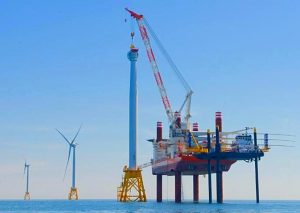
The vessel Brave Tern installs at Block Island Source: windcarrier.com
Construction of the nation’s first offshore wind farm off Block Island is complete. In early August, Deepwater Wind, the 30 MW wind farm’s developer, installed the first of five, 6 MW, GE turbines. Three miles southeast of Block Island, for each turbine, three tower sections were bolted on top of one and other, rising 270 feet. A boxy nacelle sits at the top of each tower housing the generating equipment.
According to Deepwater Wind, the trickiest part of the installation was attaching the long and unwieldy blades. At their highest points, the blades top out at 589 feet. Another challenging aspect of the project was earlier, bolting custom-built, lattice-work foundations to the sea floor.
To erect the turbines, an Oslo-based, Norwegian 433-foot vessel named Brave Tern crossed the ocean. It travelled for 16 days from Saint Nazaire, France where it picked up the five nacelles, to reach Block Island. The ship jacks itself up off the sea floor to be able to provide extreme precision for the installation of the wind turbines. Since it was built in 2013, Brave Tern has installed more than 200 wind turbines in Europe. It typically takes a day and a half per turbine for erection.
Biophilic Design
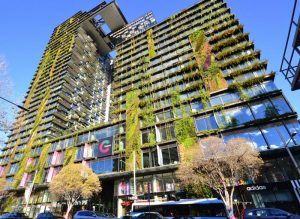
Biophilic Design in NYC at One Central Park
Lignofuels, biolubes… the vernacular grows and greens. Ever heard of biophilic design? It taps the innate buy xanax in japan human attraction to nature… known as biophilia.
“Biophilic design” is a new form of architecture. At least it is a new discipline. Bill Browning of Terrapin Bright Green, a leader purveyor of the discipline and former RMI employee, tells me that the word comes from the social psychologist Eric Fromm and was given definition by EO Wilson in his book the Biophilia Hypothesis. Arguably it’s about re-tapping the intuitively obvious… that a connection to nature feels good.
Biophilic design intends to tap the human benefits of “biophilia.” It is aimed at creating strong connections between nature and man-made environments. And its proponents claim proven benefits, from increased worker productivity, to increased creativity, better clarity in thinking, better learning for kids, to better healing for hospital patients. Its proponents even make the case that retail spaces can be more profitable.
As our society has become more and more urbanized, we have lost the connection to nature. Biophilic design is about regaining the connection… through natural lighting, views of nature, plants, natural building materials, textures, and patterns. Perhaps some day every office worker will be able to harvest his or her salad for lunch, there will be edible landscapes inside buildings, and design features to restore our connection to nature… without the bugs!
EcoMotion staff ponder the relative benefits of virtual biophilia… things like recorded sounds of rains forests and rainstorms, images of nature potentially projected on large, high-definition screens, perhaps even piping in smells to plug olfactory sensations. Would these too result in benefits? Just as light pipes allow for natural light into the depths of a structure, could virtual biophilic design also be viable?
California’s Climate Leadership Continues
 On September 8th, the California legislature made international headlines by passing California Senate Bill 32. The bill, sponsored by State Senator Fran Pavley, solidifies California as the world leader on climate protection. It’s an extension of AB 32 – also sponsored by then Assemblyman Pavley, the Global Warming Solutions Act of 2006. That legislation called for a return to 1990 greenhouse gas emissions levels. SB 32 is much more aggressive, calling for reducing GHGs to 40% below 1990 levels by 2030.
On September 8th, the California legislature made international headlines by passing California Senate Bill 32. The bill, sponsored by State Senator Fran Pavley, solidifies California as the world leader on climate protection. It’s an extension of AB 32 – also sponsored by then Assemblyman Pavley, the Global Warming Solutions Act of 2006. That legislation called for a return to 1990 greenhouse gas emissions levels. SB 32 is much more aggressive, calling for reducing GHGs to 40% below 1990 levels by 2030.
Governor Jerry Brown calls the GHG target far-sighted and far-reaching. The new law will affect nearly every aspect of our lives, from where and how we live, to how we get to work, to the food we eat and how we are powered.
The ambitious climate legislation actually involved two bills. Climate Resolve’s Director of Policy, David Fink, states that this climate milestone is “notable not just for its greenhouse gas reduction targets, but also for its emphasis on protecting vulnerable populations and transforming disadvantaged communities.” The companion bill, AB 197, gives the Legislature greater authority over the California Air Resources Board, to ensure strategies to lower emissions favor those most impacted by climate change.
Fink notes that for more than a decade, the naysayers have cried that reducing greenhouse gas emissions would devastate the economy. “Just the opposite is true. Since AB 32 was passed a decade ago, the economy has improved while unemployment has gone down and approximately half a million jobs have been created with the help of the legislation.” SB 32 makes a commitment to the clean energy economy for years to come.
The SB 32 goal will not be easy to achieve: Research from Lawrence Berkeley National Laboratory shows that current policies only get us half way to the 2030 goal. And meanwhile, California’s economy will grow from $2.5 trillion a year to $3.5 trillion, with population growing from 38 million to a projected 44 million.
“Cinching Down” on California’s Cap and Trade?
California is a world leader in terms of climate protection goals, and policies to ratchet the emissions down. The California Air Resources Board is responsible for implementing AB 32, and now SB 32. These bills specific reductions in atmospheric CO2e gases. AB 32 calls for a return to 1990 emissions levels by 2020. SB 32 calls for a 40% reduction from 1990 levels by 2030.
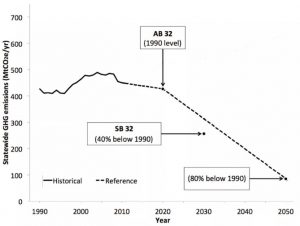
Source: Vox
To date, and while certainly not without controversy, California’s largest GHG emitters — about 600 “point-source” emitters — have been put “under the cap” of cap and trade. These emit over 80% of the State’s GHGs. They have to ratchet down their emissions to 1990 levels, or pay fines.
Over lunch in Irvine with Troy Strand and Dick Paulsen, we contemplate the impact of California’s GHG leadership. And in particular, we discuss if and when the next tier of emitters will have to comply. What about smaller businesses? What about cities? Will the cap and trade “cinch down” to these levels?
To answer these questions, I called on three leading climate advocates here in SoCal, Jonathan Parfrey of Climate Resolve, and Gary Gero, former Executive Director of Climate Action Reserve, and Craig Ebert, its current Executive Director. All three are tied in with Sacramento, the California Air Resources Board (CARB), and the implementation of the world’s most progressive climate legislation.
“Ain’t gonna happen,” is the long and the short of it. There will not be State legislation or regulation to cap smaller entities. The top 600 covers over 80% of emissions. “You’d have to regulate thousands of the next tier users.” “Imagine the hugely political firestorm….”
More fundamentally, the emissions from the next tiers are already accounted for since their suppliers of electricity and natural gas are indeed regulated. It is the primary users of fuels – refineries, power plants, and the Gas Company – that are under the cap. Their customers are their responsibility. As such, they have been and will continue to promote programs and policies to get consumers to fall in line to help them achieve their goals.
Rick Heede and the Carbon Majors
Impressed I was reading the Science magazine article on Rick Heede of Climate Mitigation Services. He is heralded for his analytical skills and for his perseverance often as a lone wolf voice in a sea of predators… in this case, major emitters. Rick’s an old friend, a former colleague and employee at Rocky Mountain Institute, daughter Skye’s godfather, a pilot, and awesome skier!
The Science article focuses on Rick’s massive database. He’s meticulously documented who’s been responsible for taking carbon out of the ground and putting it into the atmosphere. He’s spent years piecing together the annual production of energy major fossil fuel company since the Industrial Revolution and converting it to carbon emissions. Dear Rick, he’s been “working alone and with uncertain funding.”

The Carbon Majors
The results of his research are profound, that two-third’s of anthropogenic emissions originate in just 90 companies and government-run industries. Published in 2013, critics of the research claim that it unfairly held a number of companies accountable for a lifestyle of the masses. A U.C. Berkeley professor said it’s “a cop-out to blame the majors.”
To be more specific, Rick reports that just 90 companies are responsible for 63% of cumulative emissions between 1751 and 2010. Half of the emissions took place after 1988. The top emitters in 2013, the last year of data, were Saudi Aramco, responsible for 3.39% of cumulative emissions. Second in cumulative impacts was Chevron with 3.39% of emissions, and ExxonMobil with 3.11% of the cumulative, BP and Gazprom.
In 2013, Saudi Aramco also topped the list of companies with 2013 annual emissions – 1,707 million metric tons of CO2. Russia’s Gazprom was #2 with 1,135 million metric tons, followed by the National Iranian Oil Company.
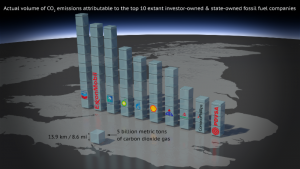
Source: CarbonMajors.org
So how did Rick get to be such a carbon accountant? Where did he get so attentive? Born in Norway, he is the descendant of a long line of watchmakers to whom he attributes his attention to detail. At age 15, he and his family emigrated to the U.S. He then attended the University of Colorado where he earned undergraduate and graduate degrees in geography.
When I first met Rick at Rocky Mountain Institute in 1986, he was deep in analysis of the hidden subsidies of old and coal. These subsidies made and continue to make the comparative economics of renewables look bad. He left RMI in 2003, moved up the hill in Old Snowmass, and formed Climate Mitigation Services. In that capacity, he began by focusing on quantifying Aspen’s emissions, not just from direct emissions, but “everything that uses energy as a result of Aspen’s existence,” like the fuel for planes bringing skiers in from far away.
Cities Going 100% Renewable

Solar on Los Angeles Metro Property
The Los Angeles City Council unanimously approved a measure that instructs its municipal utility – Los Angeles Department of Water and Power – to study an equitable transition away from fossil fuels to power Los Angeles with 100% clean energy. Now the City will convene a working group with a charge to deliver a timeframe for the study.
Los Angeles, with its commitment to study such a transition, joins Denver with a similar commitment. So far, 17 American cities are committed to a path to 100% clean energy, including Salt Lake City, Boulder, San Diego, and San Francisco. They join Paris, Sydney, and Vancouver that have established 100% clean energy targets.
L.A. is the largest American city exploring how to power itself completely with renewables. The challenge will indeed be great. L.A. is currently 40% powered by coal and 22% by natural gas.
A C40, a network of the world’s major megacities committed to combating climate change through action and collaboration, reports that 228 cities representing 436 million people have set targets that would reduce emissions by 13 gigatons of CO2 by 2050. Cities house more than half of the world’s population.
What’s Up at EcoMotion?
EcoMotion’s 2016 Solar Innovation Tour:
Join solar leaders and practitioners on November 15th for EcoMotion’s 2016 Solar Innovation Tour. City leaders, sustainability officers, advocates and new market entrants will spend with a day EcoMotion’s solar team visiting the most innovative and impressive solar systems in Los Angeles.
The 2016 Innovation Solar Tour will be full-day event. On the bus will be briefings and box lunches. We’ll be visiting Cathay Bank’s Gensler-designed solar ports, the Broadview Christian Science Nursing Home’s dual-axis tracking solar sytem,… and the largest rooftop system in the world, now under construction! The day ends with a cocktail reception at EcoMotion’s offices in the historic CalEdison Building.
Visit the Eventbrite page for more information, and to reserve your seat. The cost is $50 per person. Space is limited. Register today! ecomotionsolartour.eventbrite.com
Community Solar White Paper, Second Edition:
EcoMotion is pleased to release the second edition of the Community Solar White Paper drafted by Ted Flanigan in 2012 in collaboration with the Clean Energy Collective. At that time there were only a dozen community solar projects in America. Today, there are more than 90 projects in 25 states with a cumulative capacity of over 100 MW. And more are being developed every day. The concept is catching fire, “giving affordable access to solar to the masses.”
“Community Solar: Design Options and Innovations: Second Edition, was researched and updated by EcoMotion Project Manager Shaun Miller. The 31-page paper presents design options, innovations, lists of benefits to key stakeholders from consumers, sponsors, and utilities, plus regulatory updates from California, Colorado, Delaware, Hawaii, Massachusetts, Minnesota, Washington, and the federal government.
Please email EcoMotion to be sent the no-cost white paper.
